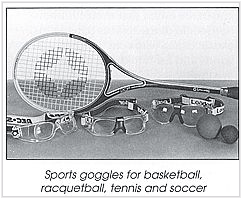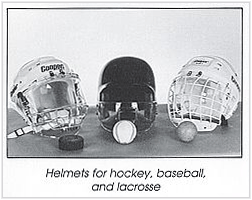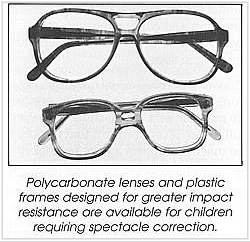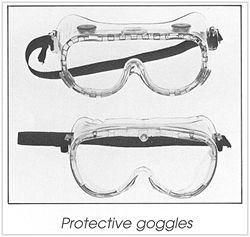Eye Safety
Accidents resulting in eye injuries can happen to anyone. But the fact is, over half of the victims are under the age of twenty-five.
Many of these injuries, over 100,000 annually, occur during sports or recreational activities. Perhaps the most startling statistic of all is that 90% of all eye injuries could have been prevented.
Parents are advised to acquaint themselves with potentially dangerous situations at home and in school, and to insist that their children use protective eye wear when participating in sports or other hazardous activities.
 Children and sports Children and sports
Increasing numbers of children are participating in sports at an early age. It is the responsibility of the parents and coaches to provide protective eyewear and enforce its use.
Some sports in which children should be made to use protective eyewear are:
-
Baseball;
-
Basketball;
-
Racquetball;
-
Tennis;
-
Soccer;
-
Hockey;
-
Lacrosse
Contact lenses are not a form of eyewear protection, and contact lens wearers require additional protection when participating in sports.
 In baseball, hockey and lacrosse, a helmet with a polycarbonate (an especially strong, shatterproof, lightweight plastic) face mask or wire shield should be worn at all times. It is important that hockey face masks be approved by the Hockey Equipment Certification Council (HECC) or the Canadian Standards Association (CSA). In baseball, hockey and lacrosse, a helmet with a polycarbonate (an especially strong, shatterproof, lightweight plastic) face mask or wire shield should be worn at all times. It is important that hockey face masks be approved by the Hockey Equipment Certification Council (HECC) or the Canadian Standards Association (CSA).
Sports goggles with polycarbonate lenses and side shields should be worn when participating in basketball, racquetball, tennis and soccer. Choose goggles that have been approved by the American Society of Testing and Materials (ASTM) or that pass the CSA racquetsport standard.
While skiing, protective glasses or goggles that filter out UV and excessive sunlight can be  useful in shielding the eyes from sunburn. useful in shielding the eyes from sunburn.
Boxing poses an extremely high risk of serious and even blinding eye injury. No adequate protection is available, although thumbless gloves may reduce the number of eye injuries.
Parents of a child with permanently reduced vision in one eye should carefully consider the risks of contact sports and injury to the good eye before allowing their child to participate.
^ back to top
Eye safety at home and in the yard
To provide the safest environment for your children, select games and toys that are appropriate for your child's age and responsibility level.
Provide adequate supervision and instruction when your children are handling potentially dangerous items, such as pencils, scissors and pen knives. Be aware that even common household items such as paper clips, elastic cords, wire coat hangers, rubber bands and fishhooks can cause serious eye injury.
 Avoid projectile toys such as darts and bows and arrows. Do not allow your children to play with air powered rifles, pellet guns or BB guns. They are extremely dangerous and have been reclassified as firearms and removed from toy departments. Avoid projectile toys such as darts and bows and arrows. Do not allow your children to play with air powered rifles, pellet guns or BB guns. They are extremely dangerous and have been reclassified as firearms and removed from toy departments.
Keep all chemicals and sprays out of reach of small children.
Do not allow children to ignite fireworks or stand near others who are doing so. All fireworks are potentially dangerous for children of any age.
Do not allow children in the yard while a lawnmower is being operated. Stones and debris thrown from moving blades can cause severe eye injuries.
Demonstrate the use of protective eyewear to children by always wearing protective eyewear yourself while using power tools, rotary mowers, line lawn trimmers or hammering on metal.
^ back to top
Eye safety in school
When participating in shop or some science labs, students should wear protective goggles that meet the American National Standards Institute (ANSI) Z87 safety code.
^ back to top
General eye safety for children
Children with good vision in only one eye should wear safety glasses to protect the good eye even if they do not need glasses otherwise. These lenses should be made of polycarbonate and be 3mm thick.
Choosing a plastic or polycarbonate frame will reduce the risk of injury from the frames themselves. Frames which meet the ANSI standards offer the best available protection for general spectacle wear.
Prescription lenses can be fitted into some types of sports goggles, but frames without any lenses do not provide adequate protection.
^ back to top
When an injury does occur
When an eye injury does occur, it is always best to have an ophthalmologist (eye physician and surgeon), or other medical doctor examine the eye as soon as possible. The seriousness of an eye injury may not be immediately obvious.
^ back to top
Copyright © American Academy of Ophthalmology
|



 In baseball, hockey and lacrosse, a helmet with a polycarbonate (an especially strong, shatterproof, lightweight plastic) face mask or wire shield should be worn at all times. It is important that hockey face masks be approved by the Hockey Equipment Certification Council (HECC) or the Canadian Standards Association (CSA).
In baseball, hockey and lacrosse, a helmet with a polycarbonate (an especially strong, shatterproof, lightweight plastic) face mask or wire shield should be worn at all times. It is important that hockey face masks be approved by the Hockey Equipment Certification Council (HECC) or the Canadian Standards Association (CSA). useful in shielding the eyes from sunburn.
useful in shielding the eyes from sunburn. Avoid projectile toys such as darts and bows and arrows. Do not allow your children to play with air powered rifles, pellet guns or BB guns. They are extremely dangerous and have been reclassified as firearms and removed from toy departments.
Avoid projectile toys such as darts and bows and arrows. Do not allow your children to play with air powered rifles, pellet guns or BB guns. They are extremely dangerous and have been reclassified as firearms and removed from toy departments.